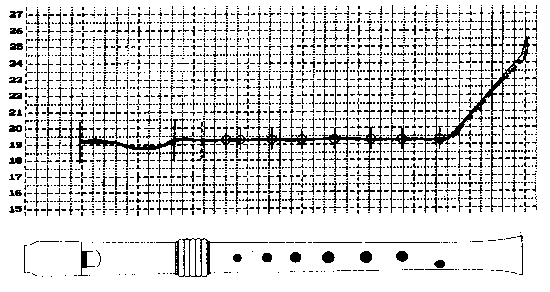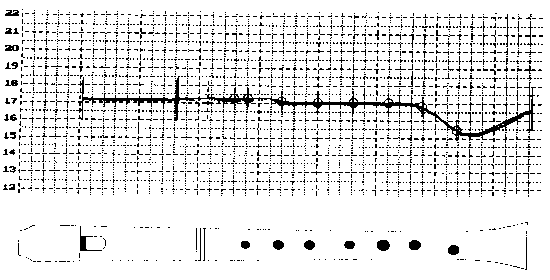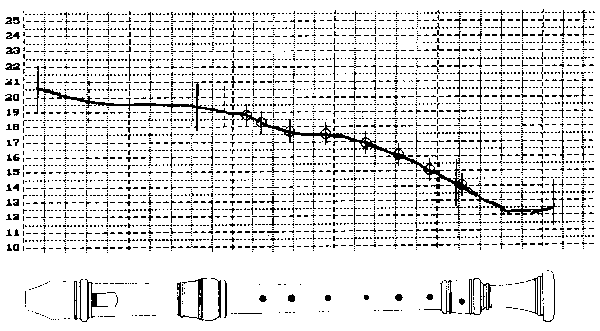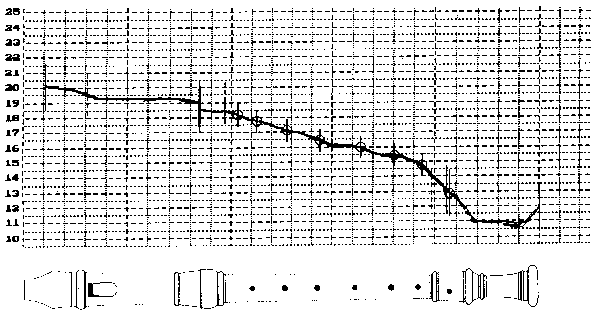Ganassi - Kynsecker - Bressan - Denner
Structural differences and their effects on musical practice
Lecture held at the ERTA Symposium, Karlsruhe 1994 English translation by Terry Simmons, Warrnambool, Australia
1 Fundamental of Recorder acoustics
The aim of this paper is to examine recorders regarding different building methods: the structural and constructional side, how structural differences affect the musical characteristics; and ranges of application of the instrument.
1.1 Relationship of Bore Profile to Tone Colour
We will examine the various factors-determining the instrument’s sound, beginning with the different profiles of the bore. Here the differences are e.g. between a Renaissance recorder, shown at its clearest in the Ganassi building method.
From elementary physics or from organ-building, we know the difference between open and stopped pipes. We know that for a given frequency, a stopped pipe is only half as long as an equivalent open pipe. Also the tone quality is different. We know that the sound of an instrument consists of the fundamental plus different partial tones. After the fundamental as the basis, the octave follows as the second, above that the fifth in addition (and/or the twelfth to the fundamental) as the third, as the fourth the double octave, as the fifth a third above that as the sixth again a fifth above the double octave and so on.
We remember that whereas the sound of an open pipe consists of all of the harmonics, the sound of a stopped pipe is comprised of the odd-numbered harmonics only: the fundamental, fifth above the octave, third above the double octave , etc. We call this rather nasal-sounding tone picture “stopped tone quality”.
Stopped pies also differ from open pipes in their over-blowing behavior. Stopped whistles can be over-blown only into odd-numbered harmonics. The typical representative is the clarinet, which cannot be overblown into the octave, but straight into the twelfth.
Between these two extremes are pipes in which the bore more or less strongly contracts towards the bottom end. In such whistles the even-numbered partials are suppressed - completely, but clearly weakened compared with the odd-numbered, so that such pies have a tendency towards a nasal or “stopped: tone quality, even though it is generally easily possible in all rule to over-blow them to the octave over a wide range.
A further factor is the bore diameter compared to the its length. The narrower the bore, the more strongly pronounced are the higher harmonics and the more easily the instrument can be overblown. In extreme cases it may be difficult to produce low notes because of the instrument’s strong tendency to over-blow. By contrast, an instrument with a relatively wide bore has, by virtue of its large air volume, a large sound, is rather poor in overtones and perhaps rather difficult to over-blow into higher harmonics.
1.2 Other sound-Determining design features
Naturally there are other design factors that play a large role in determining the sound of a recorder.
There is first the design of the “cut up”. Generally one can say that the higher it is, the louder and more direct the sound becomes. (The cut-up is the distance from the wind-way exit to the edge.)
This is particularly relevant in relation to the bore diameter. This becomes clearest, if one looks at the extreme. Thus a wide bore together with a low cut-up results in a dark, intimate sound, while a narrow bore, combined with large cut-up results in strident instruments with fast, nervous speech.
As well, there are clear differences in the direction of the wind-way in relation to the instrument’s length axis. Generally a wider bore needs to be stimulated stronger than than more narrow bores. Consequently with Renaissance instruments the windway is almost always angled slightly inwards, while with the usually narrower-bore baroque instruments they are normally parallel or even angled slightly outward the instrument.
2 Ganasso recorder
First we will have a look at the Ganassi recorder, which represents rather an extreme building method. Exactly what is it?
2.1 Background to the Ganassi Recorder
Source information about these instruments is rather sparse. The name goes back to Sylvestro Ganassi’s text book “La Fontegara”, published in Venice in 1535, dealing with the art of the recorder and of diminutions. In this book he describes sets of fingerings which, if used on different recorders common at that time, allows them to be played far beyond the then-common one and a half octaves. He claimed this as his most original discovery, but this is uncertain.
Moreover, those fingerings do not work too well in producing over-blowing to the octave in higher positions or to the double octaves on many of the instruments of this period. There are almost no recorders at all on which these fingerings work, particularly on more strongly conical-bore instruments (most recorders of the Renaissance had a contracting bore). The fingerings, for the reasons mentioned above, were not applicable in practice.
There is one original instrument, an old recorder in the Kunsthistorische Museum in Vienna, whose construction method allowed a range far beyond two octaves with the Ganassi fingerings. This instrument is practically no longer playable because of a split. Reconstructions by Fred Morgan and others however indicated that this construction method could probably represent the “Ganassi recorder” type. Most of today's instruments of this type go back to these reconstructions. If one were to go by the current proliferation of these instruments, one could easily consider it an instrument of its own type without a precise historical tradition. Today's performing practice, with strenuous efforts around historical authenticity, surely differ a great deal from those earlier times.
2,2 Building Characteristics
Now what are the structural characteristics of the Ganassi recorder?
First, the remarkable practically perfectly cylindrical bore of the instrument, with a strong funnel-like expansion at the lower end. This is in contrast to the design of nearly all other types of recorder.

Bore Profile of a Ganassi Recorder
As well, it features a comparatively large cut-up, which leads to increased sound intensity and a louder instrument.
The flare at the lower end does not only have an effect on the tone. Above all, it adjusts the intonation of the instrument within the third register. Thus it leads to the fact that the so typical fingering for the double octave (all fingers closed, only thumb hole and both ring fingers leaking) results in a correct double-octave.
This fingering is known also from baroque recorders, where it represents the (usually failed) attempt to play a high f# on an old recorder — the note a semitone above the double octave. This fingering is nearly always too sharp. The “Ganassi flare” lowers this note sufficiently that the final result is usually an in-tune double octave with good tone quality and brilliance, which are inconceivable otherwise with other instruments, even from later era, with other fingerings.
2,3 Tonal Result
This building method and the resultant tone quality of these instruments no longer has anything of the “stopped” quality. The principal characteristically of the tone colour is the open, radiating fundamental. This is true also for the quality in the third register, which is also acoustically usually simply derived due to the simple over-blown fundamental, often as direct harmonics of the fundamental.
2,4 Differences from the Consort recorder
The differences from the Consort recorders, the instruments most common at that time, are considerable. These were drilled undersize for their entire length, then reamed to produce a contracted bore and with rather narrow cut-up. The sounds of these recorders are well-known as rather intimate, dark and capable of blending well with one another.
2,5 Use in Musical Practice
Their operational characteristics place the Ganassi recorder rather within the soloistic range. It is inclined to dominate and thus has become generally accepted as equal with other wind instruments.
Its large tonal range makes it a suitable substitute in the Italian violin literature of the 16th & 17th centuries as well as generally for the brilliant, virtuoso diminuition literature. As well, the instrument is frequently used in contemporary music. Its usefulness is very extensive – one may happily play Van Eyck on it. That may not be “authentic”. But is this instrument itself at all “historically correct”?
3 Early baroque recorder
In the title of this talk, the next name specified is “Kynsecker”, a representative of early baroque recorder-making.
3.1 Which is the Early Baroque Recorder?
The question “Which is the typical recorder of the early baroque?” is difficult to answer. It was a transition period, and the surviving instruments are from quite different building method. We are dependent on relatively few instruments and written sources, with which however some characteristics crystallize. We will simply look at two important sources:
The best-known instruments from this epoch are a consort of 2 each of Sopranos, Alto and tenor recorders, and a bass of Hieronymus Franz Kynsecker of Nuremberg, which are store there today in the Germanic National Museum. These were developed only in the second half of the 17th century, but their evidently conservative building clearly reflects methods of 50 years earlier.
Kynsecker was not necessarily the greatest maker in his guild. His instruments are above all important because of their relatively good state of preservation and their distinctive shaping with the characteristic wave profile at the head pieces. Their quality of tone and speech quality are probably to be regarded at best as moderate, so that they represent more an interesting study material than a worthwhile model for reconstruction.
An interesting written source is represented by Jacob van Eyck’s “Fluyten Lust-Hof” in which the author provides, at the beginning, a short tutorial for the “handfluyt”, common at that time, in which he essentially gives the baroque fingerings common today, apart from the different fingering for the fourth note, which we have since come to call “historical” fingerings.
These fingerings, which we rely upon above all for the third register, almost always work on the original instruments of this time.
3,2 Building Characteristics
From the design point of view, throughout the first half of the 17th century, the instruments further developed as an advancement of the “classical” Renaissance recorder type, with a clear contraction of the bore at the lower end, which otherwise was often almost cylindrical or with a very slightly reverse conical bore. The finger holes are usually obviously closer together than with the old Consort recorders. Also the cut-up becomes somewhat larger.

Bore diagram of an early baroque recorder
3,3 Effect on Tone Quality
The tone quality of these instruments became, in comparison with former times, clearly more rich in overtones and more “soloistic”, the typical baroque sound developed, with its reedier becoming more evident.
The instruments most probably were however usually still able to be mixed and we might assume were often still played together in consorts along with Kynseckers.
4 The Late baroque recorder
The instrument experienced a clear change towards the end of the 17th century. The development probably had its roots in France and then by was “exported” by instrument makers to all of Europe.
Thus for instance P. Bressan brought this redeveloped type of high-baroque recorder to England, while Johann Christoph Denner domesticated the new recorder in Nuremberg following his studies in France.
4.1 Goals of the development
A notable characteristic of the new developments was the transformation of the recorder from a mere musical tool to the status of a work of art, already outwardly visible through the often complex adornment of the sections, where often rare and noble materials such as ivory came increasingly into use.
Likewise, the sound concept changed similarly More elegance increasingly demanded what was to be called: reedier tone with expressed soloistic development and above all, playing security in the high registers.
4.2 Structural Differences to the early Baroque Recorder
This may be noted in a number of constructional changes. The tapering of the bore towards the lower end is clearly steeper and begins further up than with the early baroque instruments. With it also the finger holes move closer together and are smaller. The windway becomes increasingly thinner and in the process flatter.
4,3 Tonal consequences of the development
These changes lead to strong changes in the tone quality of the instruments, which is ever more strongly covered and richer in overtones, according to the ideal of the time. Strongly soloistic, it is also less suitable for mixed playing – the baroque recorder is avowedly “soloistic”. It is not surprising that the tendency moved again towards somewhat quieter, more intimate sounds.
4.4 Different “schools”:
Now different national and regional architectural styles can clearly be discerned. Particularly interesting for instance is the comparison between the instruments of the London and the Nürnberg schools, represented by the names Bressan and Denner.
The typical English recorder was developed in London particularly by P. Bressan, who introduced the instrument of France, and the makers from the Stanesby family.
The dominant characteristic is above all the bore diameter, which is relatively wide within the lower range, and which narrows itself towards the foot joint only gradually, so that also the foot bore is still relatively wide. The wind-way and cut-up are often kept relatively narrow, with very clearly perceptible blowing resistance.

Bore profile – alto recorder of P. Bressan
The tone quality is typified by “depth” in the basic tone which is very colorful and shapeable. One automatically thinks of the influence of French music, which shines through clearly here.
The high register of these instruments, is however often not the “strongest” register, particularly regarding purity of intonation. This is not surprising, if one considers English music of this time, e.g. recorder sonatas of Händel, in which the high notes of the third register are actually required very rarely. But the music is laid out for its tonal brilliance and is conceived exactly appropriately for an original recorder from Bressan’s workshop.
A further development overtook the building of recorders in Nuremberg, at that time the most important German center of building of woodwind instruments. Doubtless due to intensive trading contacts to the South, a clear Italian influence was discernible in the making of wind instruments. Thus a southern German recorder style was developed there, which was strongly influenced by the Italian taste.
Compared particularly with the English instruments of the time, they clearly exhibit a narrower bore particularly towards the lower end; the upper half of the bore shows comparatively small differences, which were primarily intonation-driven. However, starting from the finger hole 6 the bore narrows very strongly in these instruments, so that the foot joint bore is very narrow. At their narrowest points they can be narrower by up to 1.5 mm than, for instance, with Bressan’s instruments.

Bore profile of an alto recorder after J. Denner
However the wind-way is usually somewhat wider than with the English instruments. Whilst differences of 0.5 mm may not appear too serious, here they have very clear effects tonally. Also, the wind-ways are not usually kept as fine.
The tonal results are then also completely different from Bressan. Denner instruments characterised above all out by fast and direct speech everywhere, but above all however in the high register. The sound is usually slim but sonorous in the low register, the flexibility is clearly narrower than with English recorders.
The musical significance of this recorder type becomes clear immediately, if one considers the recorder works of Telemann. In all probability this composer possessed instruments from Jacob Denner’s workshop. His music requires instruments which have to be playable virtuosically in all registers, with no “weak” registers. The instruments had to be above all agile and fast-speaking.
Words are inadequate to provide a player’s comparison between the two instrument types. One should compare appropriate copies from a good workshop.
Here it is however important to compare instruments of the same pitch since pitch affects the character of an instrument beyond its building method profoundly. Original English instruments normally had deeper pitch (A = 405 - 408 Hz) than the Nürnberg instruments (A = 410 - 415 Hz)
5 Which is the “original” sound?
5.1 Early music (to beginning of 17th century)
For the music of the Renaissance, up to the beginning of the 17th century, a particular recorder type can hardly be specified absolutely as the authentic instrument. Recorders of the Ganassi design are not absolutely certainly the instruments of this time. Nor were they usual for the Italian diminutions repertoire. The Ganassi recorder is not surely “original” in the form in which it is currently proliferating. On the other hand it puts useful possibilities at the player’s disposal: to meet the music from this time particularly and from there straight to performances for which it may appear to be suitable.
Usually the literature of this time was rarely or only loosely conceived for specific instruments. Therefore it seems quite legitimate simply to use that instrument with which it “sounds best”.
5,2 Early Baroque solo literature (e.g. van Eyck):
Likewise, the Ganassi recorder is often used for the literature of the 17th century. Alternatively, the typical early baroque recorder with its narrowed-down bore and its somewhat overtone-rich, finer sound picture would be probably more appropriate. On these instruments the notes of the upper register have a different kind of character and really sound somewhat “sensational”, giving undue emphasis to high points, contrary to the Ganassi instruments, whose high register appears more natural.
5,3 Late Baroque music
For the music of the late baroque one can align oneself well towards the respective national styles and/or the different emphases of the particular music.
Thus the instruments of the English school, such as for instance by Bressan, are particularly suited to music where tonal subtlety is required and which particularly calls for colour differentiation.
One thinks here immediately of Händel’s recorder music, but naturally also of the entire French music.
Slimmer instruments, such as those from Nürnberg, typically from Denner, are suitable particularly for literature for which speed, brilliance and virtuosity come to the fore, and where one is dependent on very agilely and fast-speaking instruments.
Telemann’s recorder works can hardly be thought about without Denner recorders. Also the Italian music of the time is very much “at home” on these instruments. Naturally one may object that for example, Corelli’s works were moved straight to London, and therefore it is “historically correct” it to play “La Follia” on an instrument after Bressan. However it is a valid point of view that one simply may decide which type makes the music sound best and represents the ideal tool in the hands of the player.
Because ultimately, musical instruments represent no end in themselves, but are always tools for the use of the player.
